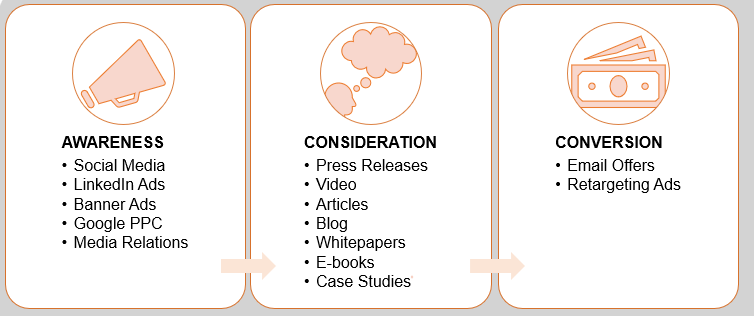The biotech/bioscience industry in the U.S. is enormous, with a staggering market size that reached $190 billion in revenue in 2022. This impressive figure reflects the growing significance and potential of biotechnology in various sectors, including pharmaceuticals, agriculture, genetics, environmental protection and healthcare. However, with the abundance of biotech/bioscience companies striving to increase their profits and establish meaningful connections with potential customers, standing out from the crowd can be a daunting challenge.
In such a competitive landscape, the key to success lies in strategic content creation and promotion. By harnessing the power of a variety of well-crafted and targeted content types, a biotech company can effectively differentiate itself and capture the attention of its desired audience.
Keep reading to learn more about enhancing your content in the biotech/bioscience space.
Content is key
Content creation plays a vital role in establishing a strong presence and building credibility within the biotech industry. Through informative blog posts, case studies, white papers, explainer videos and webinars, a biotech company can showcase its expertise, share valuable insights and demonstrate its thought leadership. By offering expert opinions backed by scientific data and personal testimonials, a biotech company can position itself as a trusted authority in its field.
Moreover, compelling content serves as a powerful tool for engaging potential customers and fostering meaningful connections. By addressing the pain points and challenges faced by the target audience, biotech companies can provide solutions and show how a product offers tangible benefits. This can be achieved through educational content that explains complex scientific concepts in a simplified manner, highlighting the potential impact of biotech innovations on human health, wellness and quality of life.
Media strategy supports content
Creating great content alone isn’t enough. It is equally important to share and promote the content effectively to maximize its reach and impact. Utilizing various marketing channels (owned, paid and earned) can amplify messaging and engage with the audience. Owned channels including social media platforms, email newsletters and the company website are a good place to start and ensure an immediate publication option. Earned channels such as industry publications, media interviews and partnerships with relevant influencers, are wonderful at building credibility with audiences. By leveraging search engine optimization techniques, the company can ensure that its content appears prominently in relevant search results, further enhancing its visibility. Paid placements also help reach the audience through search results and look-a-like demographics.
Biotech and the sales funnel
When creating content and determining placements, it’s imperative to keep the sales funnel in mind. People make decisions about health products just as they do with any other purchase. Biotech companies that want to promote a new product or simply start connecting with customers should focus first on generating awareness among key audiences through paid and owned social media, as well as leveraging media relations. Content including advertising, pay per click (PPC) placements and social media posts are common pieces of content to lean on to promote awareness.
Then, customers can be guided through the consideration and conversion phase through a strategic content marketing plan that focuses on nurturing the relationship and incorporating calls to action toward the end of the sales funnel. During the consideration phase, customers will likely seek out information online for research purposes. This is when press releases, explainer videos, blogs, byline articles, whitepapers, case studies and other informational content can help guide the customer to the desired action of purchase.
To secure the conversion (purchase), biotech companies should consider special offers as well as retargeting messages that include a strong call to action (CTA). This will seal the deal with customers, helping them feel confident in their purchase decision.
Content to tell your story
Biotech companies can leverage the power of storytelling to create an emotional connection with the target audience. Sharing successes, testimonials and real-world applications of products or services can help humanize the brand and inspire trust and loyalty among potential customers. This can be achieved through blogs, video, testimonials, case studies or interactive webinar presentations that highlight the transformative impact of biotechnology on individuals, communities and society as a whole.
Here are some types of content that biotech/bioscience businesses can utilize to tell a compelling story:
Blogs
Blogs can serve many roles in the sales funnel and are a tried-and-true way of connecting with a target audience. Brands that use blogs generally receive twice as much email traffic than those that don’t and are 13 times more likely to have a positive ROI on their efforts. Additionally, 77% of internet users read blogs, meaning that the audience is out there seeking information and actively tapping this type of communication as a resource.
Not only do they allow brands to share valuable information about how products can help solve customer and industry problems (and can be more promotional than earned media placements), but the keyword-rich content supports search engine optimization (SEO), helping the company rank higher in search. Blogs can also fuel social media, earned media and email marketing efforts.
Press releases
Press releases are a great way to share news with the media and customers alike. They are no longer only for the press, but with online release hosting, prospective customers can find the latest news about companies and products through a simple online search. One of the most important things for brands to remember is that since press releases are now online, the best approach is to boost the content with SEO strategies such as keyword inclusion, key phrases, links to other owned media and strong headlines.
Case studies
Potential customers like to see how a product has worked for someone else. Case studies are a clear and industry-appropriate way to convey important results and should focus on the challenge and how the biotech product is the solution. They can be blinded but need to have recent data and enough details to showcase the performance of the company and positive outcome of product usage. If the content is strong enough, a case study can serve as a gated asset where readers exchange contact information to gain access. A single case study, if well done, can be leveraged across media relations and email marketing as well as paid and owned social.
White papers
One white paper can be used to develop multiple earned and owned media story angles, as well as support social media efforts. White papers are often used as pillar content, spawning a variety of other assets including social media posts, images, infographics, quick facts, short-form blogs and more. Because white papers contain valuable content to the reader, it is important to share a description of what the user will gain from reading it and then it can be gated to grow the brands email database to share future content.
Explainer videos

Webinars
Webinars can provide your team an opportunity 
Calls to action
Calls to action are important and should be appropriately incorporated throughout the sales funnel. In the awareness stage, CTAs should be very soft and encourage the audience to learn more by clicking through to a blog, case study, white paper or video. As the customer travels through the sales funnel, the CTA can become stronger, such as signing up for an eNewsletter. This final step of the funnel often includes a special offer sent via email or is delivered through retargeting ads. Either way, this CTA should be clear and ask for the close.
Media relations
Once the content is created, biotech/bioscience brands can post it to owned channels. However, the promotion shouldn’t stop there. The content should also be used to leverage earned placements such as media stories, interviews, expert statements and more. Maintaining ongoing media relations momentum will help biotech brands continue to build awareness and credibility. It’s important to consider media relations when developing an editorial calendar so that important pieces of content such as press releases, thought leadership articles, responses to timely news, awards and other similar items can be shared via social media accounts.
Content in the biotech/bioscience space
The biotech industry in the U.S. offers immense opportunities, but also fierce competition. To carve out a significant share of the market, biotech companies must focus on strategic content creation and promotion. By developing high-quality content that showcases expertise, provides valuable insights and offers solutions to target audience needs, biotech companies can establish themselves as industry leaders and capture the attention (and dollars) of potential customers. By effectively promoting strategic content through various channels and leveraging storytelling techniques, they can build trust, engage with their audience and ultimately thrive in the dynamic media landscape.
The experts at Beyond Fifteen are here to help your biotech/bioscience company create a marcom strategy and compelling content that guides the target audience to awareness and through the consideration and conversion stages of the sales funnel. Connect with us to learn more!









